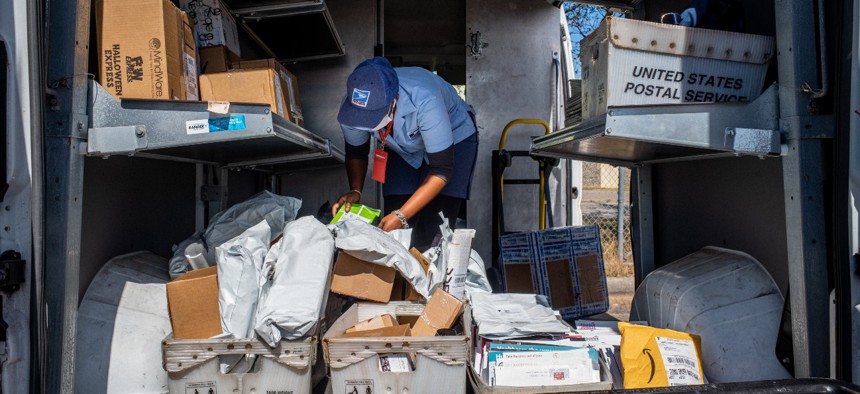
Postal employees will make a new election into the postal-specific program in late 2024 during the “open season” period. Brandon Bell/Getty Images
The Biden Administration and USPS Offer a First Glimpse of a Postal-Only Health Benefits System
The agencies are seeking to answer early questions, though they still have time to sort out details.
The Biden administration and the U.S. Postal Service have released the first bit of information related to the upcoming shift of the mailing agency’s 600,000-person workforce onto its own benefits system, though so far few details have emerged.
The Office of Personnel Management, working with USPS, on Monday launched preliminary answers to frequently asked questions about the new health care marketplace. The two agencies must set up the Postal Service Health Benefits program by late 2024 with employees, retirees and family members shifting to it by Jan. 1, 2025. Individuals who receive health insurance through USPS currently do so through the same program that serves all federal employees and retirees. Congress required the changes as part of the Postal Service Reform Act that President Biden signed into law earlier this year.
The Postal Service Health Benefits program will operate within the Federal Employees Health Benefits program, but will include plans that only serve postal workers, annuitants and their family members. The new guidance defined those eligibility categories and assured those individuals they do not have to take any immediate steps to keep their health insurance coverage. Current and former postal employees will continue to participate in FEHB for 2022, 2023 and 2024, but will make a new election into the postal-specific program in late 2024 during the “open season” period.
“OPM and the Postal Service will continue to provide updates leading up to the 2024 PSHB Open Season to help ensure a smooth transition for all eligible employees and annuitants,” the agencies said.
Other benefit programs will continue to operate as they have even after the switchover to the postal specific health care network, including dental and vision insurance, flexible spending plans, group life insurance and long-term care insurance. FEHB participants who fail to make a selection for a new plan in 2024 will be auto-enrolled in a to-be-determined nationwide offering. Under the law, USPS must set up an education program to help employees and retirees navigate the new system and make decisions appropriate to their health care needs.
The law requires OPM and USPS to make every effort to ensure any FEHB plan that has at least 1,500 postal participants is included in the postal-specific marketplace. It also will continue the same coverage and cost sharing, the exact rates for which are determined by collective bargaining agreements. The FAQs did not touch on the other major health benefits change included in the reform law, which will shift most retirees onto Medicare for their primary health insurance.
The Postal Service has reached out to some of its employee groups about the transition, though not everyone has heard from management. Brian Renfroe, executive vice president of the National Association of Letters Carriers, said USPS has been “regularly engaging” with the union regarding its discussions with OPM on the upcoming changes.
“NALC will continue to regularly meet with the Postal Service about this,” Renfroe said.
Ivan Butts, president of the National Association of Postal Supervisors, said he has asked USPS to set up a working group to allow stakeholders to participate in the process running up to the program’s launch in January 2025, but has yet to hear back. The National Active and Retired Federal Employees Association, which played a key role in shaping some of the health care provisions in the reform law, also said it has yet to engage with the Postal Service.
“We’re monitoring its rollout to ensure our members remain informed on their healthcare,” said Ross Apter, NARFE’s director of legislative and political affairs.







